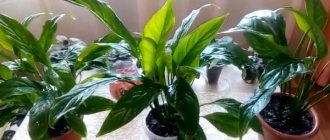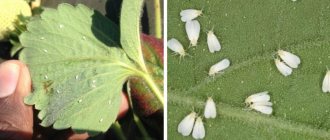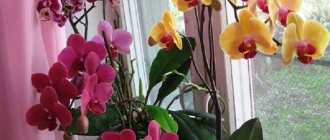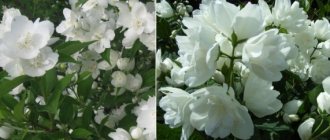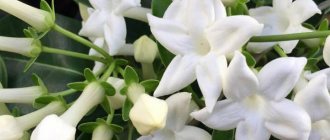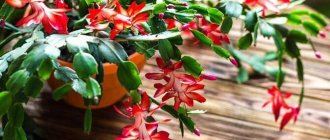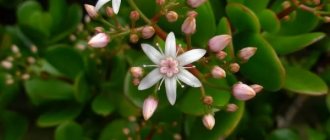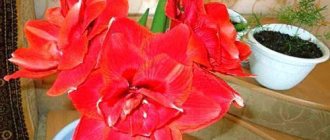Author: Elena N. https://floristics.info/ru/index.php?option=com_contact&view=contact&id=19 Category: Houseplants Published: February 17, 2019Last edits: January 11, 2021
- Growing from seeds
- The gardenia's buds are falling off
Gardenia is one of the most beautiful flowering plants in indoor culture. And, perhaps, one of the most capricious. Gardenia has won love and recognition in many countries. For the Japanese it symbolizes secret passion, for the Chinese it symbolizes femininity, grace and aristocratic fragility. Lovers of indoor plants are delighted by the beauty of gardenia flowers and leaves and its delicate, pleasant aroma. However, caring for this plant is not easy.
- How to plant and replant gardenia?
- What conditions does it need for normal development and abundant flowering?
- What kind of care will she need?
You will learn about this and much more from our article.
Planting and caring for gardenia
- Flowering: from July to October.
- Lighting: bright diffused light (placed on eastern and western window sills, shading will be required on southern windows in the afternoon).
- Temperature: from 16 to 24 ˚C.
- Watering: during the period of active growth - as the top layer of soil dries, in winter - with a delay of 2-3 days.
- Humidity: high, especially during budding.
- Feeding: young gardenias - 2 times a month alternately with mineral and organic fertilizers in liquid form, adults - every week, but the fertilizers should not contain calcium.
- Dormant period: February-March.
- Transplantation: in early spring or after flowering: young gardenias are replanted annually, adults - once every 3 years.
- Reproduction: seed and vegetative (cuttings).
- Pests: white aphids, spider mites, scale insects, mealybugs and thrips.
- Diseases: sooty fungus, chlorosis.
Read more about growing gardenia below.
Gardenia (lat. Gardenia) is a genus of the Rubiaceae family from the tropics, which is named after the American physician and naturalist Alexander Garden. In indoor conditions, the gardenia flower does not take up much space, but in nature - in East and Southeast Asia, as well as in South Africa - the gardenia plant sometimes reaches two meters in height. Gardenia, grown at home - jasmine, sometimes called "Japanese beauty" by gardeners; it came to England in 1760.
Flower growers grow it not only for the beautiful white, waxy flowers that emit a subtle jasmine scent, but also for the glossy leaves of a rich dark green color, which are a worthy decoration for gardenia when it is not in bloom.
- Ampelous pelargonium
Poor nutrition
Starting in early spring, gardenia must be fed during the growing season. This is done with organic and mineral fertilizers. A salesperson in a specialized store will suggest a high-quality drug and the required composition. If you have made the right choice, then the indoor flower will respond with lush flowering and the inflorescences will remain on the stem for a long time. And with a lack of nutrition, on the contrary, gardenia refuses to bloom.
Unsuitable components contained in the fertilizer can cause the buds to fall off and the ovaries to dry out. What to do. Feed gardenia before and during flowering with potassium-phosphorus fertilizers, which are responsible for budding. For example, “Bona Forte” or “Bud”. For root feeding, apply to slightly moist soil. Be sure to include iron supplements in your diet. Eliminate calcium and magnesium from your diet.
Features of cultivation
Gardenia jasminoides is an evergreen bush that grows in a room up to 45-50 cm in height. Its shoots are sometimes bare, sometimes pubescent; the leaves are dark green, bright, shiny, as if opened with varnish, short-petiolate, about 10 cm in length, broadly lanceolate or obovate, entire, tapering towards the base. Gardenia blooms in summer with fragrant single or few-flowered (4-6 pieces) corymbose inflorescences, axillary or apical. At the beginning of flowering, the flowers are boiling white, but gradually turn yellow. The diameter of the flowers reaches 8 cm, and varieties with double flowers are most often grown in cultivation. Caring for gardenia at home is not as simple as, for example, pelargonium, but the result is worth the effort.
So, what are the features of home gardenia:
- gardenia does not tolerate dry soil or stagnant water;
- gardenia is very demanding on air humidity, so be prepared for frequent daily spraying;
- For gardenia, soil acidity is of great importance, so conduct a soil test for this indicator before planting the plant and ensure that the pH is no more than 5.5;
- the air temperature should not be higher than 24 ºC and lower than 16 ºC if you are interested in the quality of gardenia flowering;
- Remove spent buds immediately.
Description of colors
A distinctive feature of gardenia, which makes it one of the favorites for gardeners, is its snow-white or pale pink flowers, in appearance, for the most part, similar to roses or shaped like a six-pointed star with petals curved like propeller blades. Double inflorescences and single flowers densely cover the stems. Depending on the variety, the diameter of the flowers can vary from two to ten centimeters .
Some types of gardenia have yellow petals, which can change over the life of the plant, from white when the bud opens to orange before the flower falls.
Gardenia inflorescences exude a unique fragrance.
Caring for your home gardenia
Rules of care
Find a bright, warm place in the apartment, protected from drafts, for the gardenia - the lighting should be bright, but diffused; the temperature was mentioned above - from 16 to 24 degrees. Eastern or western window sills are most suitable for the flower; northern ones are excluded, and placement on a southern window sill will require shading from the sun's rays from 11:00 to 17:00.
In winter, you will have to supplement the gardenia with fluorescent lamps, since the winter daylight hours are too short for it. But even if the place for the gardenia is chosen well and you care for it correctly, it can take a very long time to settle down, get used to it, become capricious and even drop its buds.
Watering
One of the most important points in how to care for gardenia at home is watering the plant. Gardenia requires frequent watering, especially during the period of active growth - in spring and summer, as the top layer of soil dries. In autumn and winter, water less abundantly and often, waiting until 2-3 days have passed since the evaporation of moisture from the soil surface. Once a month, water the gardenia with acidified water, and the rest of the time, water it with soft water - boiled or filtered. And be sure to be warm: the temperature of the soil in the pot should be the same as the air in the room.
Air humidity, especially during budding, should be high, so place the flower in a tray with damp moss, expanded clay or pebbles, but in such a way that the bottom of the pot does not touch the water. Spray frequently with warm water, but only until the buds begin to open: when water gets on the flower, brown spots form on it. Instead of spraying, wipe the gardenia leaves with a damp sponge. Do not move or turn the flowerpot, otherwise the plant will drop its buds in a panic.
Fertilizer
Young gardenias need to be fed twice a month with mineral and organic fertilizers alternately. For an adult plant - weekly throughout the growing season, excluding fertilizers containing calcium. It is preferable to use a liquid form of mineral fertilizers (Vito, for example) in accordance with the attached instructions.
- Homemade aloe
Gardenia benefits from peat-humic fertilizer; liquid potassium fertilizer for flowering indoor plants does not cause any complaints, but the dose must be halved than recommended by manufacturers. To normalize the pH, iron-containing preparations are added twice during the growing season. In winter, gardenia does not need fertilizing.
Transfer
The soil for gardenia should consist of equal parts of sand, turf, coniferous, peat and leaf soil. A decent drainage layer is required. We have already talked about acidity. If for some reason you cannot make the soil mixture yourself, buy soil for azaleas at the store. Gardenias are replanted in early spring or after flowering, and only if absolutely necessary. For young plants, this need exists once a year, for adults – once every three years. If you do everything right.
It is not advisable to replant a newly purchased gardenia right away; wait a couple of weeks. If you bought the plant in bloom, wait until the flowering process is complete before replanting the gardenia. In order not to cause unnecessary inconvenience to the capricious flower, transfer it to a new pot with drainage and add the required amount of soil to the pot.
Why don't the buds appear?
The tropical shrub does not please with beautiful flowering for a long time. The reasons for this situation may be negative factors affecting the general condition of the plant.
Unsuitable soil
Of course, this factor can provoke a prolonged absence of buds. As a result of frequent watering, the soil becomes compacted, preventing air from reaching the roots. Or, as a result of using hard tap water, the soil becomes alkalized.
Reference! The reason may lie in the absence of a drainage layer. As a result, liquid stagnation in the pot is possible.
What to do? Over time, water washes away acidic substances and the soil needs to be acidified .
- To do this, acidified water is used for watering once every 20-30 days.
- Dilute lemon juice (3-4 drops per 1 liter) or citric acid (a few grains per 1 liter of liquid).
- Loosen the soil regularly.
- Renew the soil and pot every 3 years.
You can read more about choosing soil and pot for gardenia here.
Lack of lighting
For full flowering of gardenia, light is urgently needed. Indoor exotics should be constantly lit, except at night. If the conditions of the house do not allow this: the windows face north, the sun is blocked by shady trees under the window.
What to do. There is a way out - use phytolamps that do not dry out the air. However, they should be placed at a distance of at least 60-70 cm from the gardenia. In summer, it is better to shade the sun’s rays with a tulle curtain, and in winter, on the contrary, place the tropical beauty in the brightest place in the house.
Humidity
It is impossible not to note this indicator, which plays a vital role in the life cycle of exotic plants. If the air space in the room is dry, then the gardenia cannot set buds at full strength.
Attention! If there is insufficient moisture, the plant, preparing for the flowering phase, often drops its buds. Then wait for the next flowering no earlier than in 12 months.
What to do. Of course, increase the humidity in the room:
- place a tray with wet sand or expanded clay;
- place an aquarium or fountain nearby;
- use a household humidifier;
- spray water from a spray bottle.
Illiterate watering
The main problem for inexperienced gardeners is an excess of liquid in the pot. It seems that if a gardenia prefers moist soil, then it needs to be watered deeply every day. In fact, it's not like that. The soil should not be allowed to dry out completely, but excessive watering is also dangerous. Especially for the root system, which in turn can rot.
What to do:
- Adapt the frequency of watering.
- Moisten the soil after the top layer of soil has dried.
- Use only warm water.
- For irrigation, use rain, filtered or boiled water.
- Check if the drainage holes at the bottom of the pot are clogged and clean if necessary.
Gardenia propagation
Growing from seeds
Growing gardenia from seeds is not the best way to propagate the plant. Only freshly collected seeds are suitable for propagation, since they quickly lose their viability. Before planting in soil for azaleas, the seeds must be soaked for 2-3 hours in Zircon or aloe juice - stimulants, then sow the seeds on the soil and sprinkle the same mixture on top through a sieve with a layer of 0.5 cm, carefully water, cover the container with the seeds with film or glass and keep warm, ventilating from time to time for 1-2 hours. Shoots will appear no earlier than in a month. If seedlings appear in autumn-winter, they will have to be artificially supplemented with light.
Gardenia cuttings
When the gardenia has finished blooming, it is usually cut back to two-thirds the length of the shoots, removing weak shoots and thinning if the bush has become too dense. During the growth period, from time to time you also have to pinch one shoot or another, stimulating tillering. These cuttings are the material for propagating gardenia - apical and semi-lignified. The length of the shoot should be about 10 cm. The substrate for cuttings is a 1:1 mixture of river sand and peat. Keep the cuttings in a pale pink solution of potassium permanganate for half an hour, plant them in the ground and cover with glass or film to ensure a greenhouse effect.
The temperature should be 25 ºC, it is necessary to regularly ventilate the cuttings and moisten the soil. You can speed up root formation by arranging bottom heating for the cuttings. Once the cuttings have taken root, they are transplanted into azalea or mature gardenia potting soil, and when they reach a height of 15 cm, they are pinched to encourage the appearance of side shoots. When the side shoots grow 10-12 cm in height, they are also pinched. When the young gardenia becomes a bush, it is transferred to a larger pot.
Trimming
To form a decorative gardenia bush, you need to prune it. The right time is after flowering or just before planting. To do this, the shoots are shortened by about half. To avoid harming the flower during active growth, you should pinch new shoots at the very top of the bush.
Pruning the bush will stimulate the growth of additional lateral shoots and will ensure lush flowering and even formation of the bush in the next season.
Tip: Shoots that were pruned during pinching are suitable for flower propagation.
Trimming methods
The main technique for achieving a spherical crown is to prune all side shoots in early spring. There is no need to touch the leaves. On an elongated seedling you need to pinch the bud located at the very top, then you can create a neat tree. To do this, only 3-4 buds are left at the top, all the rest are cut off along with the foliage. After waiting for noticeable growth of the left branches, pinch the buds on them too.
Watering the flower with a large volume of water a day before the planned pruning will help to significantly ease the impact of pruning on the flower. Then treat the cut areas using charcoal.
Diseases and their treatment
The gardenia's buds are falling off
Sometimes this problem begins at the moment of bud formation: the temperature regime has been disturbed. Strictly ensure that the temperature stays between 20-18 ºC during the day and 18-16 ºC at night. If the temperature is too high at night, buds may not form at all. And no sudden changes! Watering gardenias should be regular. Insufficient air humidity or improper lighting, drafts, moving a flowerpot with a flower from place to place - any violation of the rules for caring for gardenia can lead to the plant losing buds. Therefore, be vigilant and disciplined.
- Aloe arborescens – agave
Gardenia turns black
The simplest explanation for why gardenia leaves turn black is that it is not watered correctly. Either the soil is too dry, or it has been too wet for a long time - this is why the leaves of the gardenia turn black and fall off. Pere
The soil
Gardenias are acid-loving plants, so they prefer slightly lower soil. Conventional peat-based soil mixtures meet this criterion. When planting outdoors, it is best to test the soil and make any necessary amendments to create the ideal conditions for the plant. A teaspoon of agricultural sulfur mixed into the planting hole can help lower soil levels.

